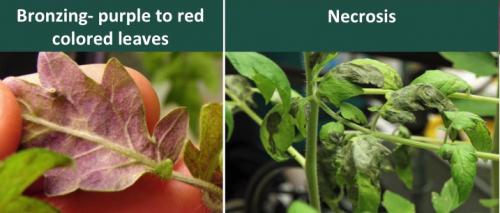Disease or disorder: How do I tell the difference? Part 1
Learn how to identify disorders to ease your scouting in the greenhouse and field. A prerecorded webinar on vegetable diagnostics is now available at the Online IPM Academy.

Scouting your vegetables in the greenhouse and field will help you identify potential issues early on. In most cases, the earlier you detect an issue, the more effective the management tactics can be. But what are the differences between a disease and a disorder? Among the webinars Michigan State University Extension is offering at the Online Integrated Pest Management (IPM) Academy, the webinar titled “What is wrong with my vegetable plants?” discusses the differences between vegetable diseases and disorders.
Since vegetable transplant production will start soon, let’s focus on how to pinpoint disorders in the greenhouse. The nutrients plants require are available as soluble salts. Nitrate, ammonium, potassium, calcium, magnesium, chloride and sulfate contribute to the soluble salts in greenhouse growing media. The substrate can be charged with nutrients but sometimes it is not. Guidelines for soluble salt content can be found in the MSU Extension article “Diagnosing plant problems – don’t forget about pH and soluble salt content” and the MSU Extension bulletin E1736, “Greenhouse growth media: Testing and nutrition guidelines.” Electrical conductivity (EC) is a measure of the soluble salts and indicates salt accumulation in the growing media.
On the other hand, the pH of the media influences the availability and uptake of nutrients. Vegetable transplants grown in media with inadequate pH (lower or higher than optimum) can develop nutrient deficiencies or toxicities. Monitor growth media and irrigation water pH frequently. Closely monitor nutrient and soluble salt content weekly, or twice a week if possible, by randomly selecting plug trays throughout the facility. This proactive approach is very important in maintaining your greenhouse fertility plan when needed while preventing nutrient deficiency and toxicity. Consider investing in a portable instrument that allows you to measure pH, EC and meters for nitrate-N and K petiole sap testing and nutrient solutions.
The most common disorders in vegetable transplants are nutritional disorders related with pH, soluble salts and irrigation. The symptoms associated with nutrient imbalances include chlorosis, necrosis, change in color of the foliage and stunting.


Symptoms of nutritional deficiency in tomatoes. Top symptoms are nitrogen deficiency, bottom symptoms are phosphorous deficiency. Photo credit: Robert Kosinski, Clemson University
Chlorosis is a yellowing due to breakdown of plant’s chlorophyll, or because its production is disrupted. Necrosis or cellular death results in tissue turning dry and brown to black. Necrosis usually occurs first along the leaf margins, but can expand over time. Anthocyanin and other pigment concentration changes and as a result, leaf bronzing can occur. Stunting is a noticeable delay in growth. When nutrient deficiencies occur, one or a combination of symptoms arise, for example stunting can be associated with off-color (dark green or yellow).
Preventative management tactics are the best approaches to managing disorders. Plan ahead your fertility management strategy and design adequate watering schedules to keep the nutrients in the media available to the plants while decreasing the potential for nutritional deficiencies or toxicities. Once transplanted in the field, avoid overwatering vegetable seedlings. The article “Don’t overwater your vegetable seedlings” will walk you through some considerations.
If symptoms arise in the greenhouse or the field, it is important to be able to recognize diseases on vegetable transplants in the greenhouse. On occasion, some symptoms observed may be the result of a pathogen. Disease symptoms also include chlorosis, necrosis and stunting. If you have additional questions, find an MSU Extension expert or collect and send samples to MSU Diagnostic Services. Remember, correct diagnosis is the first step to effective disease management.
Do not miss the chance to learn more about IPM basics, scouting guides and more at the Online IPM Academy. Accommodations for persons with disabilities may be requested by contacting Erin Lizotte with MSU Extension at taylo548@msu.edu to make arrangements. Requests will be fulfilled when possible.
For Part 2 of this series, see “Disease or disorder: How do I tell the difference? Part 2.”
Additional resources
- Greenhouse media growth media: testing and nutrition guidelines, MSU Extension bulletin E1736
- Root Media and Fertility Management for Organic Transplants Webinar, eXtension.org
- Management of Non-Pathogenic Fruit Disorders of Tomato in Organic Production Systems, eXtension.org
- Fertilizer Management for Greenhouse Vegetables - Florida Greenhouse Vegetable Production Handbook, Vol. 3, University of Florida (keep in mind this publication is NOT only for seedlings production)



 Print
Print Email
Email


